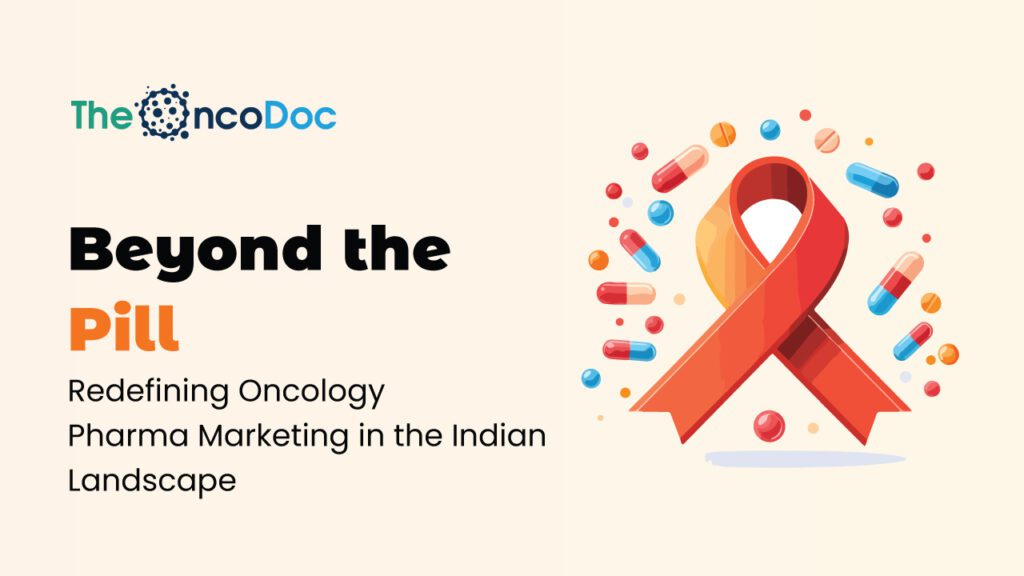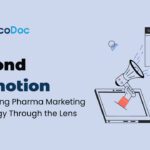Introduction: The Evolving Role of Pharma in Oncology
In India, cancer has emerged as one of the most pressing public health challenges of the 21st century, with over 1.4 million new cases diagnosed annually and rising incidence rates in both urban and rural populations. As treatments advance and the complexity of oncology deepens, the role of pharmaceutical companies is undergoing a transformation. No longer is pharma merely a supplier of drugs, it is becoming a stakeholder in comprehensive cancer care.
This evolution is redefining pharmaceutical marketing. The traditional sales-centric model is no longer effective in an environment where oncologists are overwhelmed with scientific literature, face increasing patient loads, and must adhere to nuanced clinical protocols. What oncology practitioners seek today is not promotional content, but practice-enabling solutions, content that speaks to real challenges in diagnosis, treatment planning, patient communication, and survivorship.
This article explores how pharma marketing in oncology can evolve to meet these expectations, offering data-driven insights, practical engagement formats, and support tools that address clinical and emotional complexities. From empowering oncologists with real-world data to supporting caregivers with culturally relevant materials, we unpack how pharma can pivot from promotion to partnership.
Section 1: Why Traditional Oncology Marketing Is Losing Relevance
Despite significant financial investment, traditional pharma marketing strategies, like conference sponsorships, product brochures, and routine rep detailing, are rapidly losing traction in the oncology sector. The dynamics of cancer care have evolved, but many marketing approaches remain static, leading to a disconnect between pharma communication and oncologist expectations.
The key issues are threefold:
- Oversaturation of communication: Oncologists now receive over 120 pharma communications per week, including emails, e-detailers, and WhatsApp messages. Most of these are ignored, not due to lack of interest in innovation, but because they often fail to deliver real clinical utility.
· Comprehensive messaging: Cancer is not always treated in the same way. A treatment pathway for head-and-neck cancer in Delhi differs significantly from breast cancer protocols in Chennai. However, most pharma content remains generalized and fails to reflect regional nuances or sub-specialty differentiation.
- Demand for clinical relevance: With rising emphasis on evidence-based, personalized medicine, oncologists increasingly seek resources that reflect local patient demographics, co-morbid conditions, and socioeconomic realities. Global trial data and product-centric brochures often lack the contextual applicability needed in Indian settings.

Key Takeaway: Oncology marketing must shift from mass communication to meaningful conversation. By offering context-aware, practice-aligned content, pharma can re-establish its relevance, not as a promoter, but as a partner in patient care.
Section 2: Regional Realities Matter, Marketing Must Be Local
India is not a homogenous healthcare market. Oncology practice differs vastly across regions due to access disparities, cultural beliefs, healthcare infrastructure, and socioeconomic variables.
For instance:
- In Tier 2/3 towns, late-stage presentations are more common due to delayed detection and referral.
- In urban metros, awareness of immunotherapy and genomic testing is higher, but affordability remains a concern.
- Cultural sensitivity plays a huge role in topics like HPV vaccination, fertility preservation, or palliative care.
Pharma’s Role:
- Develop localized data reports highlighting treatment response in Indian sub-cohorts.
- Partner with regional oncologists to co-create educational tools in local languages.
- Avoid “one-size-fits-all” visual branding, tailor communication to regional practice nuances.
Mini Case Insight: A pharma company launched a Tamil-language nutrition guide for patients undergoing head and neck radiotherapy. Its uptake in Tamil Nadu exceeded expectations, with over 3,500 downloads in 45 days and shared widely by doctors through WhatsApp.
Section 3: Empowering Oncologists with Practice-Enhancing Content
In today’s oncology practice, where time is a critical resource and clinical complexity continues to rise, oncologists are shifting their preference toward practical, concise, and clinically actionable content. Pharma marketing strategies that once centered solely around drug promotion are no longer sufficient. To resonate with modern clinicians, companies must offer tangible tools that support daily practice.
Oncologists now value resources that are bite-sized, time-saving, and directly relevant to patient care. Key examples include:
- Treatment pathway charts that map therapy options according to Indian clinical guidelines and patient-specific factors such as cancer stage, comorbidities, or age.
- Short-form CME (Continuing Medical Education) decks designed for tumor board meetings or quick peer consultations.
- Patient management tools, such as symptom checklists, side-effect trackers, and follow-up planning guides, which help improve care continuity and patient communication.
These materials are particularly effective when integrated into the oncologist’s workflow, whether through hospital portals, MSL interactions, or digital field visits.

This data reveals a clear trend: brevity with clinical relevance wins engagement. Pharma marketers must adapt their content strategy accordingly, focusing less on comprehensive dossiers and more on curated, easily digestible formats that meet oncologists where they are, in the midst of complex, fast-paced decision environments.
Tip for Pharma Teams: Don’t focus solely on novel therapies. Even within standard-of-care regimens, supportive content can differentiate your brand by making a clinician’s job easier and improving patient care outcomes.
By offering tools that enhance, not interrupt, clinical practice, pharma companies can transform from content distributors into trusted collaborators in the fight against cancer.
Section 4: Bridging the Communication Gap with Patients and Caregivers
In oncology, treatment success is influenced not only by medical intervention but also by the quality of communication between physician and patient. Yet, oncologists often face significant challenges when translating complex medical information, such as mechanisms of action, therapy schedules, and potential side effects, into language that diverse patients can easily understand. With varying levels of literacy, language fluency, and emotional readiness among patients and caregivers, effective communication becomes both critical and complex.
This is a key area where pharmaceutical companies can deliver value beyond the molecule, by empowering clinicians with tools that simplify, personalize, and humanize the patient conversation.
One highly effective intervention is the development of regional-language explainer animations. For example, a short, engaging video titled “How Radiation Therapy Works” in Bengali or Kannada can visually walk patients through the procedure, expected outcomes, and precautions, reducing fear, enhancing informed consent, and fostering trust.
The caregiver toolkit, which can be printed, is another useful resource. These kits can include post-chemotherapy care guidelines, nutritional advice, do’s and don’ts, and emotional wellness tips tailored to the patient’s treatment stage. When provided in vernacular languages and simple layouts, they serve as invaluable support to family members, who are often the primary caregivers in Indian households.
Furthermore, mobile-based symptom tracking apps allow patients to log real-time side effects such as fatigue, nausea, or mucositis. When integrated with the clinician’s system, these logs can help doctors adjust treatment plans promptly and improve follow-up discussions.
Actionable Idea: Add QR codes on drug packaging or prescription folders that link to short educational videos or lifestyle guidance. These should be mobile-optimized, regionally adapted, and easy to access with minimal data usage, especially in Tier 2/3 towns.
By supporting patient education and communication, pharma can build deeper, more meaningful engagement, not just with oncologists, but with the very people their therapies are meant to help. This empathetic approach strengthens trust, enhances treatment adherence, and ultimately aligns pharma branding with better care outcomes.
Section 5: Leveraging Real-World Evidence to Tell Local Stories
While randomized controlled trials (RCTs) remain the gold standard in clinical research, they often fail to capture the complexity of real-world patient populations, particularly in India. Oncologists practicing in Tier 2 and Tier 3 cities frequently encounter patients with multiple co-morbidities, financial barriers, and varying levels of health literacy. These nuances are rarely addressed in global clinical trials, creating a gap between evidence and applicability.
Today’s oncology specialists are increasingly asking context-specific questions such as:
- “How did this drug perform in a diabetic, post-menopausal cohort?”
- “Are there any studies on Indian patients aged 65 or older?”
- “What are the treatment adherence and dropout rates in semi-urban cancer centers?”
To meet these evolving needs, pharma companies must invest in generating real-world evidence (RWE) by collaborating with regional oncology centers, government hospitals, and private clinics. Such localized data not only enhances credibility but also boosts confidence in therapeutic decision-making.

This breakdown highlights a growing demand for data that mirrors India’s unique clinical, demographic, and economic landscape.
Winning Example: A leading pharmaceutical company conducted a case series of 150 colorectal cancer patients treated across Gujarat, evaluating response rates, side effect profiles, and overall survival. When published and disseminated among local oncologists, this study not only demonstrated that the drug performed well in regional settings but also led to increased therapy adoption in similar geographies.
By providing RWE that resonates with frontline practitioners, pharma can position itself as a reliable partner in clinical care, not just a product provider. More importantly, this approach empowers oncologists to make decisions grounded in the realities of their patient populations, bridging the gap between evidence and experience.
Section 6: Partnering with Patient Advocacy and Support Networks
Beyond clinics, pharma has the opportunity to engage with support ecosystems, patient groups, NGOs, and caregiver forums. These partnerships can amplify education, improve access, and enhance public trust.
Examples of initiatives:
- Workshops for caregivers on managing chemotherapy fatigue
- Awareness drives in colleges and workplaces around breast self-examination or oral cancer from smokeless tobacco
- Funding for mobile diagnostic vans in underserved districts
Such interventions allow pharma to earn social capital, positioning themselves not just as manufacturers, but as allies in the cancer journey.
Section 7: Integrating Marketing with Clinical Workflow
The most effective pharma engagement is seamlessly embedded into clinical routines. Instead of asking oncologists to visit external portals or attend webinars, marketing must flow into their daily environments.
Ideas include:
- Pre-consultation digital alerts on new dosing options based on EMR entries
- Interactive tablets for reps, allowing doctors to quickly compare regimens by cancer stage
- Treatment calculators or dosing charts embedded into e-prescription software
Case Outcome: An oncology brand integrated its dosage titration chart into an OPD registration system in a Mumbai cancer center. The result? 62% increase in therapy consistency and improved physician perception.
Section 8: Field Force Evolution: From Product Pushers to Practice Advisors
The field force remains central to pharma marketing. But reps and MSLs must upskill to engage in value-based discussions, not just product promotion.
What works:
- Field reps offering clinical summaries of new papers, not only promotional folders
- MSLs hosting micro-CME discussions in coffee break sessions
- Reps enabling access to patient education tools, post-consultation
This shift from promotion to partnership can greatly enhance pharma’s reputation in oncology clinics.
Section 9: Ethical Marketing in a Life-and-Death Specialty
Marketing in oncology isn’t just about strategy, it’s also about sensitivity.
Do’s:
- Obtain clear permissions for data usage
- Respect confidentiality in case studies
- Ensure non-promotional tone in patient content
Don’ts:
- Avoid exaggerating survival benefits without balanced context
- Never overstate off-label benefits
- Don’t push aggressive pricing in economically vulnerable populations
Pharma must act as a responsible educator, not an opportunistic seller. Trust is the only currency in cancer care.
Section 10: Metrics That Matter: From Impressions to Impact
Pharma must move beyond vanity metrics like “email opens” or “booth visitors.” In oncology, the true success of a campaign lies in improved clinical confidence, better patient understanding, and more efficient workflows.
Relevant KPIs for Marketing in Oncology:
· The quantity of oncologists who use a decision support tool each week
· Feedback and attendance rate for CME sessions
· Following an educational intervention, the patient satisfaction score
· Recurring use of patient material for more than ninety days
- Increase in early referrals due to awareness campaigns
Example: A pharma company tracking its QR-linked video views found that 85% of caregivers who viewed nutrition videos returned with follow-up questions, improving dietary compliance and therapy tolerability.
Conclusion: The New Playbook for Oncology Pharma Marketing
Oncology is not just another specialty. It is a deeply human, emotionally charged, and data-intensive domain, where every decision can alter the trajectory of a life.
Pharma marketing, in this space, must rise to the occasion. The future belongs to companies that:
- Respect clinical complexity
- Add value beyond their molecule
- Listen more than they speak
- Collaborate instead of command
By embracing empathy, real-world insight, and contextual relevance, pharma can reposition itself not as a vendor, but as a trusted partner in healing.
That’s not just good marketing. That’s good medicine.
The Oncodoc team is a group of passionate healthcare and marketing professionals dedicated to delivering accurate, engaging, and impactful content. With expertise across medical research, digital strategy, and clinical communication, the team focuses on empowering healthcare professionals and patients alike. Through evidence-based insights and innovative storytelling, Hidoc aims to bridge the gap between medicine and digital engagement, promoting wellness and informed decision-making.



